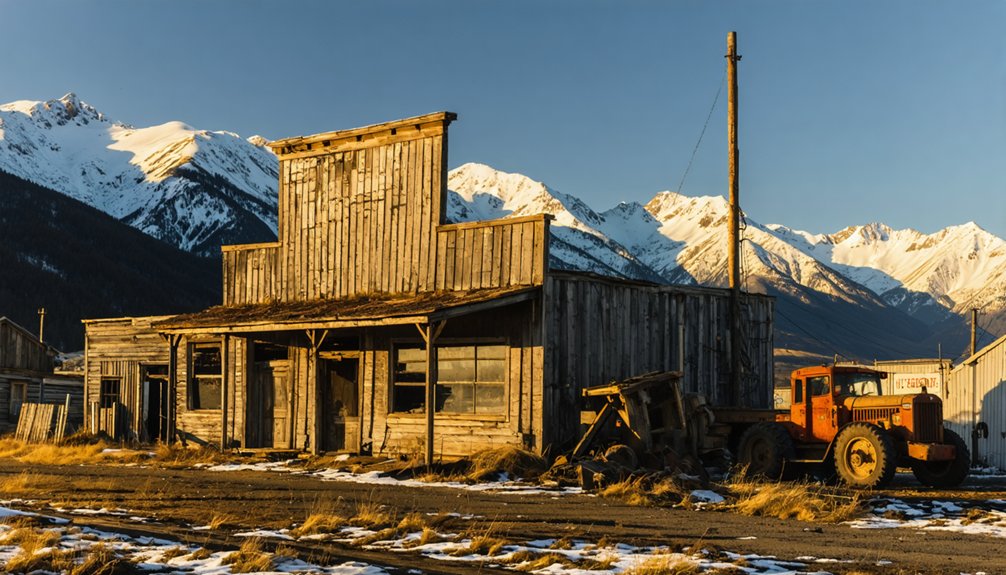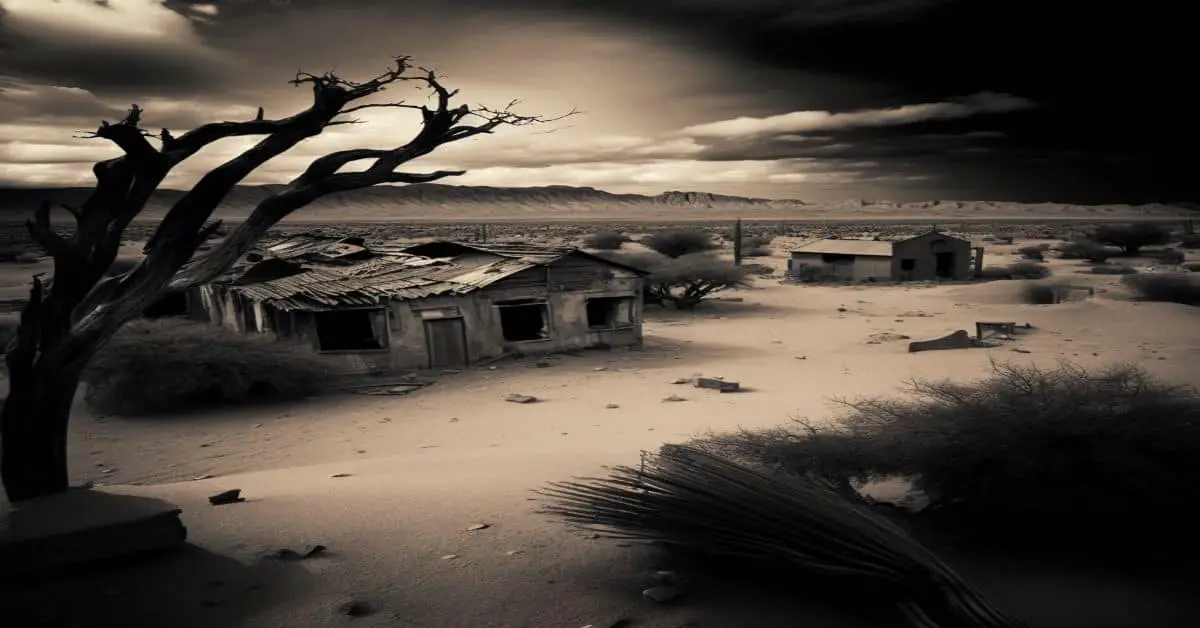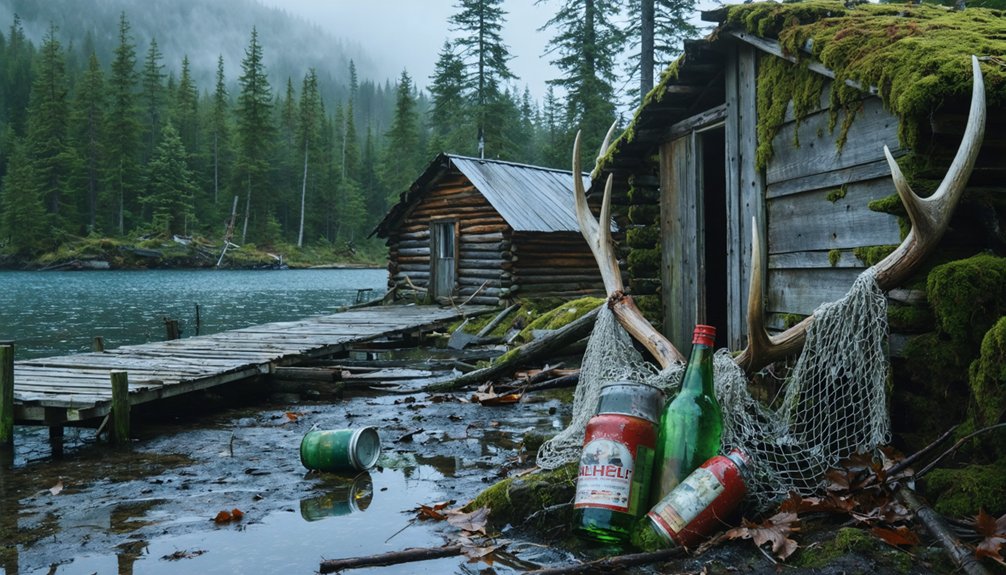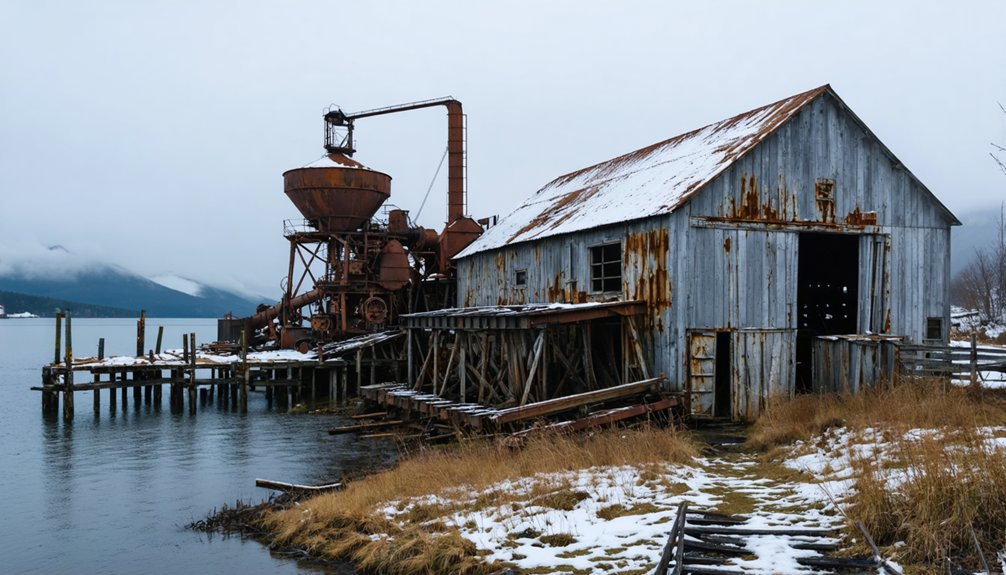You’ll discover Portage’s haunting remains 47 miles southeast of Anchorage, where a devastating 9.2 magnitude earthquake struck in 1964. This once-thriving mining transport hub dropped 6-10 feet during four minutes of violent shaking, transforming it into a saltwater-soaked ghost town. Today, you can explore the haunting ghost forest, decaying buildings, and partially submerged ruins that mark where this bustling community once stood. The site’s dramatic story of destruction unfolds with each muddy step.
Key Takeaways
- Portage was transformed into a ghost town after the 1964 magnitude 9.2 earthquake caused the ground to sink 6-10 feet.
- The former transportation hub now exists as marshy mudflats, with abandoned buildings and a haunting ghost forest of dead trees.
- Saltwater intrusion from Cook Inlet killed the vegetation, creating an eerie landscape of preserved dead trees called the ghost forest.
- Located 47 miles southeast of Anchorage along Seward Highway, visitors can explore the remnants through highway turnouts.
- The site features interpretive signs, partially submerged cabin ruins, and abandoned horse stables marking the former township’s location.
The Rise of a Mining Transport Hub
While World War II catalyzed Portage’s transformation into a major transport hub, the town’s strategic location on Cook Inlet had already positioned it as an essential link between coastal shipping and Alaska’s interior.
Much like the historic sectionhouse at Bird Creek, Portage served as a vital railroad stop for travelers and cargo.
You’ll find the town’s mining logistics were critical for supporting gold rush camps and copper operations, with its rail facilities at milepost 64.2 enabling efficient transfer between ships and trains.
As a key waypoint on the Iditarod Trail, Portage’s transport connections proved invaluable for moving heavy equipment, food, and fuel to remote mining sites.
The town’s infrastructure supported year-round supply routes, whether by summer rail service or winter dog sled teams. Locals enjoyed serving drinks with 1,000-year-old glacier ice to travelers passing through.
You could see freight moving from Alaska Northern Railway to boat landings, then across Cook Inlet to mining camps like Knik.
The Day Earth Shook: March 27, 1964
Disaster struck south-central Alaska at 5:36 p.m. on March 27, 1964, when North America’s most powerful recorded earthquake released its magnitude 9.2 fury. The ground shook for an excruciating four to five minutes, forever changing Portage’s landscape. Local residents were forced to evacuate the area permanently.
You’d hardly recognize the town after it dropped a staggering 6-10 feet, transforming it into a saltwater-soaked ghost town.
The earthquake’s devastating power, which would later revolutionize earthquake preparedness and seismic engineering standards, left Portage’s buildings in ruins.
Massive ground fissures split the earth, while soil liquefaction destroyed roads and structures. The Seward Highway and Alaska Railroad suffered severe damage, cutting off crucial transportation links. The disaster caused $27 million in damage to the Alaska Railroad system alone.
What remained of Portage now lies beneath the tide, with only scattered ruins and dead “ghost forests” marking where a thriving community once stood.
Nature’s Reclamation: The Ghost Forest
After Portage sank beneath the tides in 1964, nature began its stark reclamation of the land through what’s now known as the ghost forest. As the ground subsided 6 to 12 feet, saltwater from Cook Inlet flooded the root systems of countless trees, killing them where they stood. The town was devastated by the 1964 earthquake, which remains the second-largest earthquake ever recorded in history. The devastating tremors lasted 4 minutes as residents watched their town crumble.
You’ll now find these skeletal sentinels rising from mudflats and marsh, marking the boundary between land and sea.
The ghost forest tells a powerful story of ecological succession, as freshwater habitat transformed into tidal wetlands. What you’re witnessing isn’t just dead trees – it’s a symbol of nature’s raw power and adaptation.
Nature’s transformation unfolds before us – dead trees become silent witnesses to the unstoppable cycle of ecological change.
These ashen trunks serve as both cultural reflection and scientific laboratory, preserving the memory of what was lost while teaching us about coastal wetland development after catastrophic change.
Life Before the Great Quake
Before the earth shook and waters rose in 1964, Portage thrived as a bustling transportation hub 47 miles southeast of Anchorage. You’d find yourself at a crossroads of Alaska’s crucial transportation history, where railroads met highways and coastal routes connected to interior passages.
If you’d stopped in Portage during its heyday, you’d have discovered a lively community dynamics unlike anywhere else. The local bars and restaurants weren’t just pit stops – they were gathering places where you could sip drinks cooled with thousand-year-old glacier ice. The establishment’s signature drink featured miniature icebergs chipped directly from nearby Portage Glacier. The vibrant town life would come to an abrupt end when the Good Friday earthquake struck at 5:36 p.m. on March 27.
Mechanics kept travelers’ vehicles running while railroad workers managed cargo shipments. The town’s strategic location between Anchorage and the Kenai Peninsula made it essential for adventurers, traders, and families alike, creating a unique blend of frontier hospitality and practical necessity.
What Remains: Ruins and Remnants
If you visit Portage today, you’ll find brick fragments, wooden remnants, and scattered foundations dotting the mudflats where homes and businesses once stood.
A haunting “ghost forest” of dead, gray trees stretches across the landscape, killed by saltwater flooding when the land sank 6-10 feet during the 1964 earthquake. The catastrophic 9.2 magnitude quake shook the region for nearly five minutes, permanently altering the Alaskan coastline. The former settlement now attracts visitors to the Wildlife Conservation Center nearby.
While most of the original townsite now lies submerged beneath Cook Inlet’s high tides, the remaining structural ruins and skeletal forest serve as stark reminders of nature’s devastating power.
Scattered Foundations Still Stand
While Portage’s original townsite lies mostly submerged beneath Turnagain Arm’s mudflats, scattered ruins and foundations still stand as silent witnesses to the devastating 1964 earthquake.
You’ll find these scattered remains primarily along the Seward Highway near Portage Lake and the Alaska Wildlife Conservation Center, where building fragments emerge during low tide.
The haunting “ghost forest” of dead tree trunks intertwines with the ruins, marking where the land sank 6-10 feet.
These skeletal trees, their roots still gripping sunken foundations, reveal the historical significance of multiple seismic events.
While wooden structures have largely deteriorated under tidal waters, you can spot abandoned vehicles and railroad structures from safer vantage points along designated lookout areas, avoiding the dangerous mudflats that now characterize this transformed landscape.
Dead Trees Tell Stories
The ghost forest of Portage stands as nature’s most haunting memorial to the devastating 1964 earthquake.
You’ll find these dead trees frozen in time, their lifeless trunks reaching skyward like silent sentinels of a tragedy that transformed the landscape forever.
When the land dropped 6-10 feet below high tide, saltwater flooded the once-thriving woodland, poisoning the root systems.
The ecological impact was swift and merciless – while the trees didn’t fall, they died standing, creating an eerie reflection of nature’s power.
The ghost forest reveals clues about how ecosystems respond to seismic events, as muddy geysers shot 50 feet high and ground plates shifted independently, disrupting the soil that once nourished these mighty trees.
Today, you’re witnessing the stark aftermath of one of Alaska’s most dramatic environmental transformations.
Legacy of Loss and Transformation
Few natural disasters have transformed an Alaskan community as dramatically as the 1964 Good Friday Earthquake did to Portage. When the 9.2-magnitude quake struck, it sank the town 6 to 12 feet, forever altering its destiny.
You’ll find more than just another abandoned settlement here – Portage’s legacy speaks to nature’s raw power and humanity’s vulnerability.
The cultural impact resonates through documented histories, photographs, and oral accounts of the tight-knit community that once called this place home.
The environmental consequences remain starkly visible in the haunting ghost forest, where dead trees still stand as silent witnesses to the saltwater intrusion.
What you’re seeing isn’t just decay – it’s a powerful reminder of how quickly life can change when nature reshapes the landscape.
Visiting the Abandoned Township Today
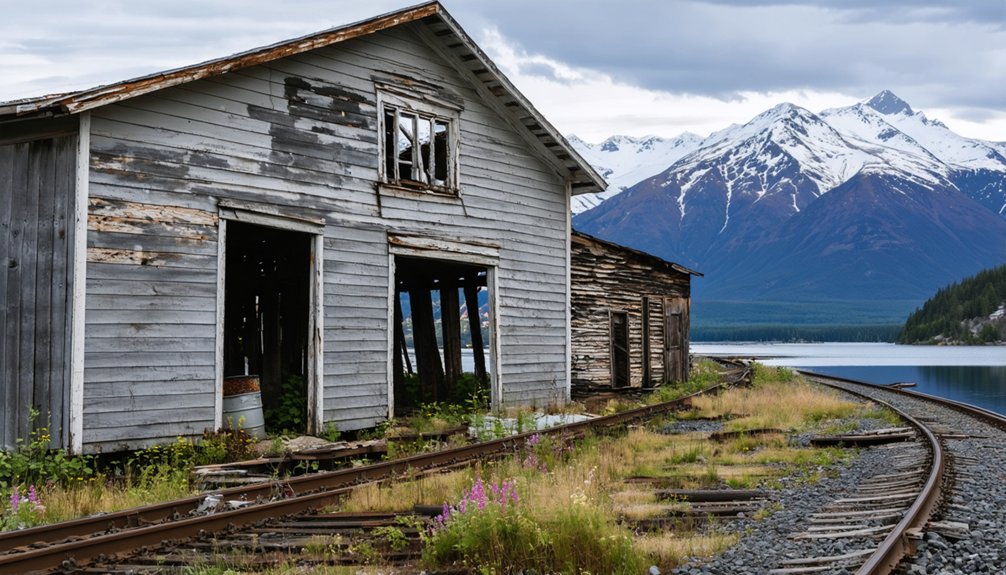
Located along the Seward Highway about 47 miles southeast of Anchorage, modern-day Portage exists primarily as marshy mudflats where a vibrant township once stood.
Once a thriving community, Portage now lies submerged in mudflats along Alaska’s Seward Highway, 47 miles from Anchorage.
You’ll find the ghost town’s remnants visible from highway turnouts, where you can spot decaying buildings and the haunting “ghost forest” – dead trees killed by saltwater flooding.
The site’s most striking features include abandoned horse stables and partially submerged cabin ruins, with interpretive signs marking key locations.
When visiting, time your trip around the tides, as the former townsite floods during high tide.
You’ll want to bring appropriate footwear for marshy terrain and a camera to capture the dramatic mountain scenery.
While there aren’t any guided tours, you can combine your visit with nearby attractions like Portage Glacier for a fuller historical experience.
Frequently Asked Questions
Are There Any Surviving Residents of Portage Still Alive Today?
You’ll find that Portage history records indicate some survivors are likely still alive today, though no official documentation tracks former residents, leaving much of Portage folklore to their untold stories.
What Was the Total Population of Portage Before the 1964 Earthquake?
Like a fading echo in time’s valley, you’ll find Portage’s pre-earthquake population was under 300 souls, with historical significance centered on its role as a transport junction before population decline erased it.
Were There Any Attempts to Rebuild Portage After the Earthquake?
You won’t find any major rebuilding efforts in Portage after the 1964 earthquake aftermath. The town’s severe subsidence of 6-10 feet below tide level made reconstruction impractical, leading to complete abandonment.
Is It Legal to Collect Artifacts From the Abandoned Town Site?
You shouldn’t acquire heritage items – it’s strictly forbidden. Legal regulations require permits for any artifact collection, and preservation laws protect these sites. You’ll face penalties if you remove anything without authorization.
Do Any Original Buildings From Portage Still Stand Completely Intact?
No, you won’t find any completely intact original buildings. The abandoned structures were either destroyed or submerged by the 1964 earthquake, with no historical preservation efforts maintaining any surviving structures.
References
- https://www.atlasobscura.com/places/portage-ghost-town
- https://www.youtube.com/watch?v=sd4x4k-GBk0
- https://www.alaska-stories.com/p/how-portage-alaska-became-a-ghost
- https://www.thealaskalife.com/blogs/news/portage-the-sunken-alaska-ghost-town-that-nature-is-reclaiming
- https://www.route-fifty.com/cards/geography-disaster-risk-and-resiliency-america-alaska/4/
- https://www.alaska.org/detail/portage-in-the-1964-earthquake
- https://www.komoot.com/highlight/6005059
- https://www.alaskahandbook.com/places/portage-townsite-ruins-and-ghost-forest/
- https://en.wikipedia.org/wiki/Portage
- https://kmtacorridor.org/communities/
